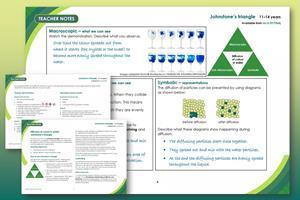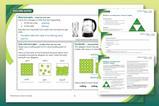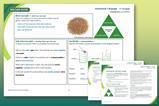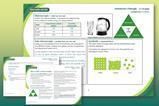Use Johnstone’s triangle to help learners explain diffusion using the particle model
Diffusion happens all around us all the time. We can use coloured compounds to visualise the movement of particles.
-

Download this
Use this student worksheet to introduce diffusion at three different conceptual levels based on learners’ observations.
View and download more Johnstone's triangle worksheets
Learning objectives
- Describe the process of diffusion.
- Explain diffusion using the particle model.
How to use Johnstone’s triangle
Use Johnstone’s triangle to develop learners’ thinking about scientific concepts at three different conceptual levels:
- Macroscopic: what we can see. Think about the properties that we can observe, measure and record.
- Sub-microscopic: smaller than we can see. Think about the particle or atomic level.
- Symbolic: representations. Think about how we represent chemical ideas including symbols and diagrams.
For learners to gain a deeper awareness of a topic, they need to understand it at all three levels.
When introducing a topic, do not try to introduce all of the levels of thinking at once. This will overload working memory. Instead complete the triangle over a series of lessons, beginning with the macroscopic level and introducing other levels, in turn, once secure.
All of the levels are interrelated, for example, learners need visual representation of the sub-microscopic in order to develop mental models of the particle or atomic level.
Further reading
Read more about how to use Johnstone’s triangle in your teaching with these articles:
- Develop deeper understanding with models
- Improve students’ understanding with Johnstone’s triangle
- Practical ideas for using Johnstone’s triangle
Norman Reid’s book The Johnstone Triangle: The Key to Understanding Chemistry provides an more in-depth overview, the first chapter is available to read online.
Teacher demonstration
Use this demonstration of the diffusion of colour in water, or the alternative learner activity, to encourage learners to observe and describe the macroscopic diffusion of colour in water.
Equipment for teacher demonstration
- Petri dish containing water
- Tweezers
- Crystal of potassium managanate(VII)
WARNING: irritant (skin and eyes); harmful if swallowed.
DANGER: oxidiser (may intensify fire).
Very toxic to aquatic life with long-lasting effects.
Stains glass, plastic, clothing and skin.
Avoid direct contact and store in the dark.
See CLEAPSS Hazcard HC081. - Visualiser
Method
Wear eye protection
- Position the Petri dish underneath a visualiser.
- Add the crystal carefully to the water.
- Learners write the observation in the macroscopic section of the Johnstone’s triangle worksheet.
Alternative learner activity
Equipment per learner pair
- Petri dish
- Water
- 1 colour sweet (e.g. Skittle or Smartie)
Method
- Carefully pour a small volume of water into a Petri dish.
- Place a coloured sweet in the centre and observe.
- Write down observations in the macroscopic section of the Johnstone’s triangle worksheet.
Scaffolding
It is important to share the structure of the triangle with learners prior to use. Tell them why you want them to use the triangle and how it will help them to develop their understanding. Use an ‘I try, we try, you try’ approach when you are introducing Johnstone’s triangle for the first time.
Next steps
To further develop learners’ thinking in all areas of Johnstone’s triangle, try our Developing understanding of diffusion and dissolving worksheet or our Developing understanding of diffusion and chemical reactions. These connect understanding of diffusion to other topics and include icons in the margin referring to the conceptual level of thinking needed to answer the question.
Downloads
Diffusion of colour in water Johnstone's triangle student worksheet
Editable handout | PDF, Size 0.26 mbDiffusion of colour in water Johnstone's triangle teacher guidance
Handout | PDF, Size 0.31 mbDiffusion of colour in water Johnstone's triangle student worksheet
Editable handout | Word, Size 0.65 mbDiffusion of colour in water Johnstone's triangle teacher guidance
Editable handout | Word, Size 0.69 mb























No comments yet